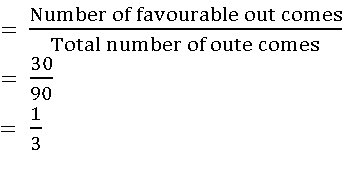Chapter 13: Probability
1.P(x) + P (“not x”) =
P(x) + P (“x కానిది”) =
(1) – 1 (2) – 2
(3) 1 (4) 2
Answer: (3)
2. If a two-digit number is choosen at random, then the probability that number choosen is a multiple of 3.
రెండంకెల సంఖ్యలో ఒక డాన్ని తీసుకుంటే, అది 3 యొక్క గుణిజమయ్యే సంభావ్యత

Answer: (2)
Total two-digit numbers = 90
Two-digit Numbers multiple of 3 are 12,15,18,21,24,27,30,33,36,39,42,45,48,51,54,57,60,63,66,69,72,75,78,81,84,87,90,93,96,99
Total two-digit numbers multiple of 3 = 30
We know that probability

3. A die is thrown twice, then the probability of 5 will come up at least once.
ఒక పాచికను రెండు సార్లు దోర్లిస్తే కనీసం ఒకసారి ముఖంపై 5 వచ్చు సంభావ్యత

Answer: (1)
Possible Outcomes are:
(1, 1), (1, 2), (1, 3), (1, 4), (1, 5), (1, 6)
(2, 1), (2, 2), (2, 3), (2, 4), (2, 5), (2, 6)
(3, 1), (3, 2), (3, 3), (3, 4), (3, 5), (3, 6)
(4, 1), (4, 2), (4, 3), (4, 4), (4, 5), (4, 6)
(5, 1), (5, 2), (5, 3), (5, 4), (5, 5), (5, 6)
(6, 1), (6, 2), (6, 3), (6, 4), (6, 5), (6, 6)
So, the total number of outcomes = 6×6 = 36
Number of events when 5 comes at least once = 11(5+6)
∴ Probability of 5 will come up at least once = 11/36
4. Three coins are tossed simultaneously, then the probability of getting at least two heads is
మూడు నాణాలను వరుసగా ఎగుర వేస్తే, కనీసం రెండు బారుసలు వచ్చే సంభావ్యత

Answer: (3)
The possible outcomes = {HHH, HHT, HTH, HTT, THH, THT, TTH, TTT},
Number of possible outcomes = 8
Favourable outcomes = HHT, HTH, THH and HHH
Number of favourable outcomes = 4
Probability of getting at least two heads = 4/8 = 1/2
<< Page 13 of 14 >>
Pages:
1 2 3 4 5 6 7 8 9 10 11 12 13 14






